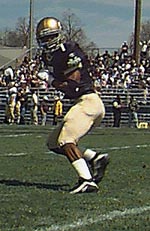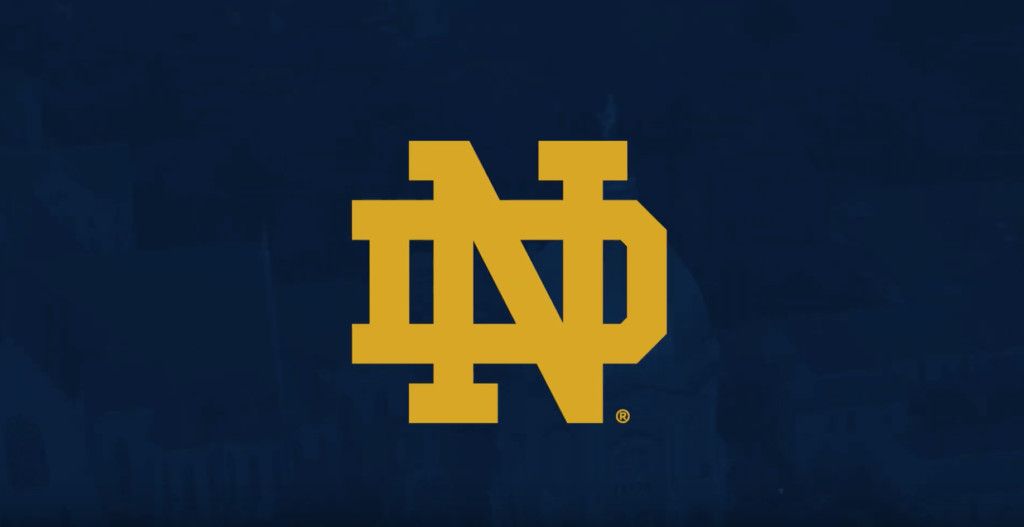Sept. 19, 1999
by Paul Camarata
The most accurate descriptions often contain the fewest words.
“Smart player.”
“Very physical.”
“Great leader.”
“Great person.”
Brief, perhaps. A’Jani Sanders, of course.
Sanders returned to the Notre Dame secondary this fall with the starting strong safety position firmly in hand.
This anointing seemed inevitable for a player who, while having to fight his way to the top of the depth chart, has done nothing but earn glowing reviews from his teammates and coaches.
It has been a struggle sometimes for the fifth-year veteran, but one in which accomplishments have ultimately outnumbered obstacles.
While the rugged safety’s playing career may have started with a big bang, ironically, it has been an evolution ever since.
Despite a high school All-America career at Houston’s Northbrook High School, Sanders did not see game action as a true freshmen in 1995.
It was not long into the 1996 season opener against Vanderbilt, however, that Sanders proved the integrity of his accolades.
With the Commodores looking to knot the score late in the fourth quarter, a jolting Sanders hit forced the fumble which ensured a 14-7 Irish victory. That hit began a long line of A’Jani-explosions that have continued right into the 1999 season opener, in which a textbook tackle in the first quarter forcibly coaxed the football from a Kansas ballcarrier. Between the Vanderbilt and the Kansas games, however, rivers have passed under A’Jani Sanders’ football bridge.
Following the Vanderbilt game in ’96, Sanders would start against Purdue and in front of friends and family when the Irish traveled to play Texas. But, the trip to Austin would prove bittersweet as Sanders tore knee ligaments that would sideline him for the next three games.
As his rehabilitation neared its end, he was penciled back into the starting lineup against Boston College before suffering a greater, more emotional setback – the death of his mother Bertha.
The sudden death was tragic for Sanders. Their close relationship, including the conversations with her that Sanders used to unwind after games, was a vital element in his transition to Notre Dame.
It is the rest of his family, however, that Sanders credits with helping him persevere after her death. Sanders may not have considered the great value of such support as a high school senior and he likely did not realize the great distance between Houston and South Bend.
In choosing to attend Notre Dame, Sanders has succeeded in bridging both the physical and emotional distance.
“My family does not get to see me a lot, because I don’t make it home much,” Sanders says, his expression and tone indicative of sincerity. “When we played at Texas in 1996, they came up, but television exposure sure helps.”
The exposure that the Sanders family tuned into in ’96 would prove to be only a sample of what was ahead.
Although losing his starting role in fall camp to classmate Benny Guilbeaux, Sanders played in all 13 games for the Irish in ’97, including late-season strong safety starts against West Virginia and Hawaii. In a heavily anticipated road matchup at LSU, Sanders’ two interceptions led an unbending Irish defensive effort that helped thwart the Tigers 24-7. Sanders also played a vital role on the Irish special teams in ’97 with 168 appearances – ranked third on the team. The total spoke both to Sanders’ vital role on the defense as well as his expanding role on the team.
In 1998, Sanders again got started strong by registering 14 tackles and forcing a fumble against defending national champion Michigan.
By season’s end, he garnered seven starts in the Irish defensive backfield, including in the Gator Bowl against Georgia Tech, splitting time in the remaining five contests with classmate Deke Cooper.
Sanders also led the team in interceptions in 1998 with three, the most notable coming at Arizona State, where he returned the ball 25 yards for a touchdown.
Playing behind three veteran senior linebackers and a talented defensive line, Sanders still finished the year sixth in total tackles with 58.
The versatility shown in his sophomore season again proved a strength as a junior, as Sanders lined up at the free safety position with the defensive unit while recording 56 more appearances on special teams.
Still for all he has seen and accomplished, Sanders’ return as a fifth-year player means more to the 1999 Irish defense than just statistical integrity.
Despite starting the season as the active career leader in interceptions (five) and passes broken up (six), and second in tackles (134), Sanders’ presence on the field and in the locker room has provided stalwart leadership on a Notre Dame team whose overall image has otherwise tended toward the youthful size.
“I’ve been here for a while along with Deke Cooper and Deveron Harper,” says Sanders. “They got a lot of experience. With three seniors back there, we are looked at as a strength of the defense.”
Sanders confidence in both his teammates and the nucleus which they form on the field is evident.
His willingness to lead off of it, however, can not be overlooked.
It is a quality which Sanders values, a torch he seems to be carrying from several teammates past. The names LaRon Moore, Shawn Wooden and Brian Magee may not instantly resonate with the average Irish fan, but their influence is one that has marked Sanders’ years after their departure.
“Those older guys from years ago, my freshmen year, were hard-nosed type players that really helped the secondary,” says Sanders. “Last season, (linebacker) Bobbie Howard was a captain and he didn’t say too much. He just went out and showed what he could do. He said, ‘Let’s do it,’ he did it and so we have to do it too.”
But Sanders hopes his leadership role will transcend the game and practice fields to infect teammates with positive energy.
“I let them know that they can ask me any question about any position and I also bring a little laughter to help everybody stay relaxed,” says Sanders.
By combining this knowledge and laughter, Sanders seems ready to inform on any matter, including the identity of the defense’s hardest hitter.
“Myself, of course,” Sanders says with a smile, adding, “I would say the hardest hitter on the team, pound for pound.”
Having noted models such as Wooden and Howard to emulate is ideal for any young player, but clearly Sanders has earned his own place upon the prestigious mantle of revered Irish leaders.
Banking on at least some measure of familiarity during his final year in the program, Sanders and the rest of secondary are under the guidance of first-year assistant coach Lew West.
“For me it was strange,” says Sanders. “I had had the same coach for four years (Tom McMahon) and now we have a new coach. It was a little different. Coach West came in and let us know he was the leader of the secondary.”
Sanders’ sterling character and professional manner have obviously not been lost on West during his first year.
“A’Jani has made my transition very easy,” says West. “He’s just a great person as far as coaching. He does a great job of being a leader. He is just a very physical, conscious player.”
The reports on Sanders do not form a pattern as much as they do a staircase.
Each transcends the next, building toward the type of reputation that is most noticeable outside the boxscore.
Not a bad impression can be found of the player who wears number five for the Irish, a player who has studied, practiced and competed his way to the top.
Still, when asked to describe himself, Sanders says little.
On the field – ” a hitter,” off the field – “real.” His description may not contain many words, but as Sanders has shown, the most accurate descriptions rarely do.
 |
| Notre Dame senior strong safety A’Jani Sanders led the Irish in interceptions last year with three and also made 58 tackles – including two for a loss. |







